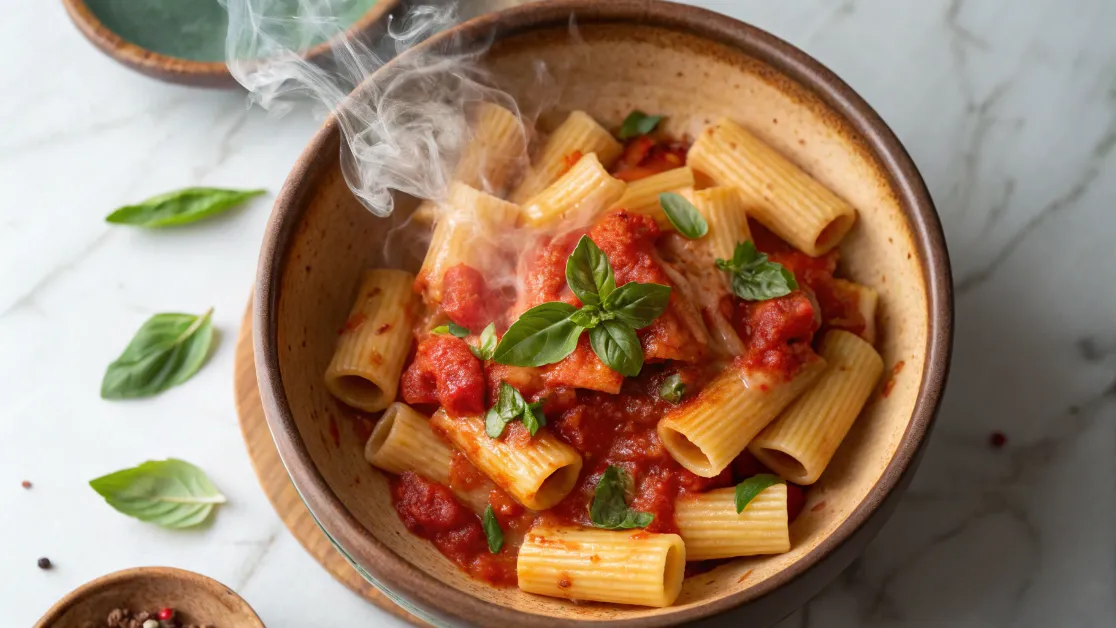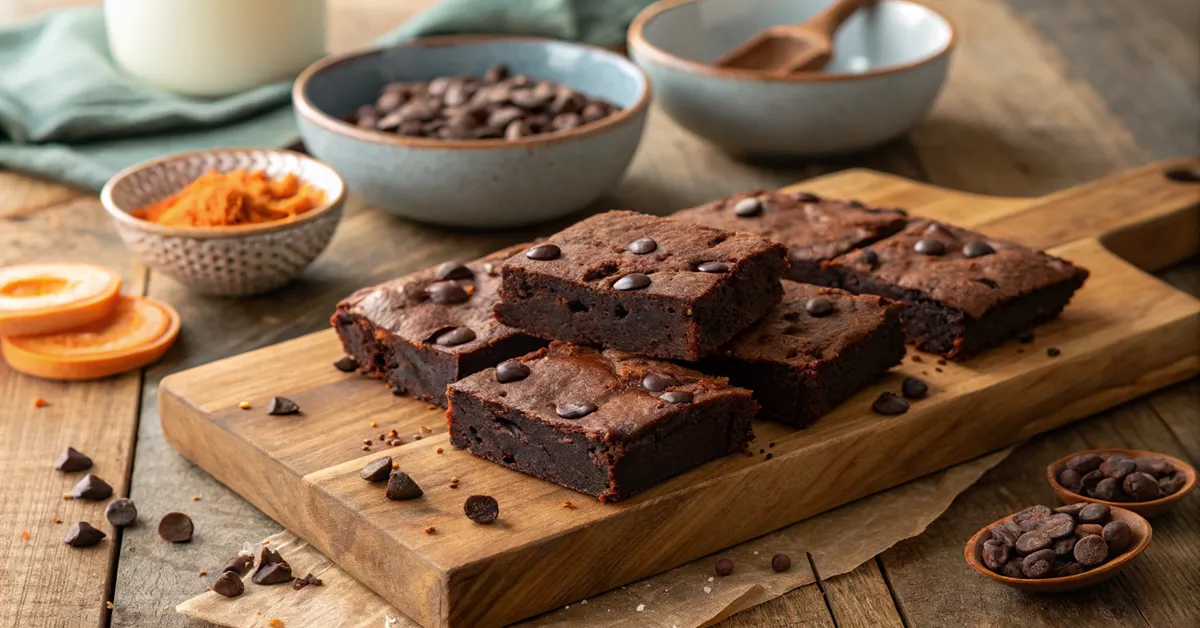The Ultimate Rigatoni Pomodoro Recipe: My Messy Journey to Pasta Perfection (And Why I Almost Gave Up)
The Night I Almost Ruined Dinner (And My Pride)
Okay, so… deep breath… let me tell you about the night I almost served my mother-in-law what can only be described as “tomato soup with pasta casualties.” It was supposed to be my signature rigatoni pomodoro – you know, that supposedly foolproof Italian classic that even culinary disasters like myself should be able to nail.
Picture this: It’s 2022, post-pandemic dinner parties are back, and I’m desperately trying to prove I’m not just another millennial who survives on DoorDash and existential dread. My husband Marco (yes, really – I married into an Italian family, the pressure is REAL) had been bragging about my “amazing” cooking to his mom for months. The thing is, my “amazing” cooking repertoire consisted of exactly three dishes, and rigatoni pomodoro was about to be attempt number four.
Spoiler alert: it didn’t go well initially.
But here’s the thing about rigatoni pomodoro – it’s simultaneously the most forgiving and most unforgiving pasta dish ever created. (Does that make sense? Probably not, but stay with me here.) Get it right, and you’re basically channeling the spirit of every Italian nonna who ever lived. Get it wrong, and… well, let’s just say I learned why my local pizzeria keeps their number on speed dial.
Table of Contents
Table of Contents
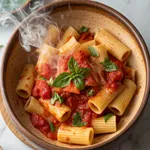
Classic Rigatoni Pomodoro
- Total Time: 35 minutes
- Yield: 4-6 servings
- Diet: Vegetarian
Description
Authentic Italian rigatoni pomodoro featuring tube pasta in a simple yet flavorful tomato sauce with garlic, fresh basil, and Parmesan cheese. This recipe delivers restaurant-quality results using just a few high-quality ingredients.
Ingredients
1 lb rigatoni pasta
1 (28 oz) can San Marzano tomatoes, crushed
1/4 cup extra virgin olive oil
4 garlic cloves, minced
1/2 cup fresh basil leaves
1 cup freshly grated Parmesan cheese
1/4 tsp red pepper flakes (optional)
Salt and black pepper to taste
Instructions
Bring large pot of salted water to boil
Heat olive oil in large skillet over medium heat
Add garlic, cook 30 seconds until fragrant
Add crushed tomatoes, season with salt, pepper, red pepper flakes
Simmer 15-20 minutes until sauce thickens
Cook rigatoni 1 minute less than package directions
Reserve 1 cup pasta water, drain rigatoni
Add pasta to sauce, toss with pasta water until well coated
Remove from heat, add basil and Parmesan
Serve immediately
Notes
- Use San Marzano tomatoes for best flavor
- Don’t skip reserving pasta water – it helps bind the sauce
- Fresh basil added at the end prevents wilting
- Freshly grated Parmesan melts better than pre-grated
- Prep Time: 10 minutes
- Cook Time: 25 minutes
- Category: Mediterranean Dinner Recipes
- Method: Stovetop
- Cuisine: Mediterranean/Italian
Nutrition
- Serving Size: 1 cup
- Calories: 445 Cal
- Sugar: 8g
- Sodium: 320mg
- Fat: 12g
- Saturated Fat: 3g
- Unsaturated Fat: 8g
- Trans Fat: 0g
- Carbohydrates: 68g
- Fiber: 4g
- Protein: 16g
- Cholesterol: 8mg
What Makes Rigatoni Pomodoro So Special (Spoiler: It’s Not What You Think)
The Philosophy Behind Perfect Pomodoro
Here’s where I’m gonna get slightly pretentious for a hot minute (bear with me). Rigatoni pomodoro isn’t just pasta with tomato sauce – it’s like… the little black dress of Italian cuisine. Simple, elegant, and somehow always appropriate.
The word “pomodoro” literally means “golden apple” in Italian, which is what tomatoes were called when they first arrived from the Americas. (Fun fact I learned during my 3 AM Wikipedia rabbit hole after my initial rigatoni pomodoro disaster.) Pomodoro sauce is basically the foundation of Italian cooking – it’s what separates the real deal from that jarred stuff that shall not be named.
Why Rigatoni? Why Not Spaghetti?
Look, I love spaghetti as much as the next person, but rigatoni is where it’s at for this dish. Those little tubes? They’re basically tiny sauce-catching machines. Each piece of mezze rigatoni (that’s the shorter version, for those keeping track) holds onto that rigatoni pomodoro goodness like it’s trying to save it for later.
My friend Sarah always argues for penne, but honestly? Penne is just trying too hard. Rigatoni has this casual confidence that I aspire to in my daily life. (Did I just compare myself to pasta? Yes. Am I sorry? Not really.)
Ingredients List: The Simple Magic (Seriously, That’s It?)
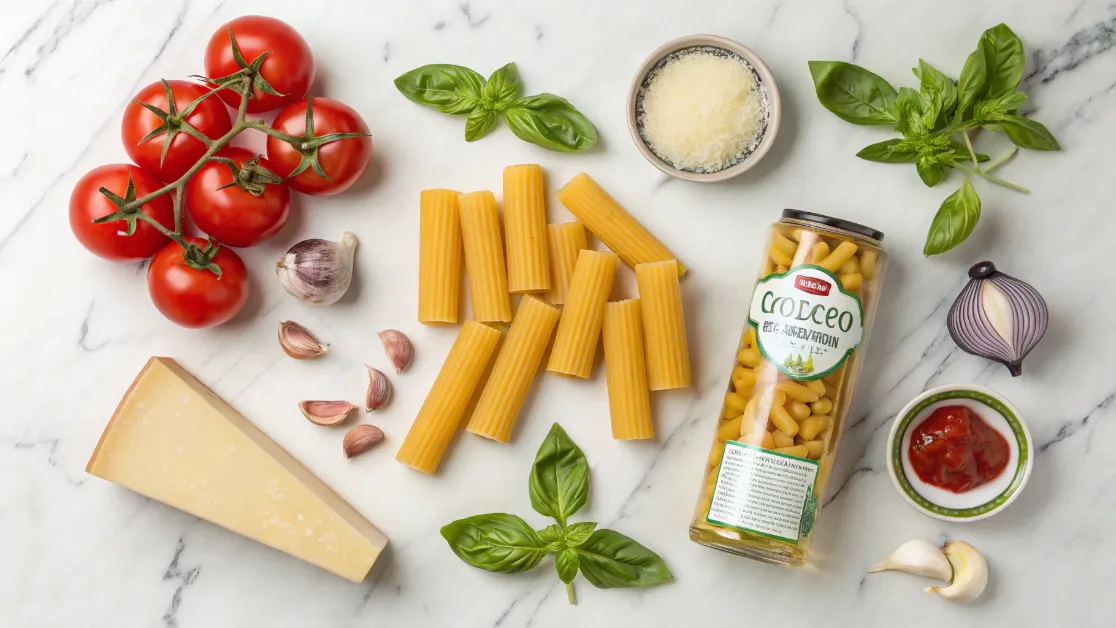
The Holy Trinity (Plus Friends)
| Ingredient | Amount | Why It Matters |
| Rigatoni pasta | 1 lb | The star of the show |
| San Marzano tomatoes | 28 oz can | Don’t cheap out here |
| Extra virgin olive oil | 1/4 cup | Good quality = game changer |
| Garlic | 4 cloves | More is more |
| Fresh basil | 1/2 cup | The aromatic magic |
| Parmesan cheese | 1 cup grated | Freshly grated only |
| Salt | To taste | Kosher, please |
| Black pepper | To taste | Freshly ground |
| Red pepper flakes | 1/4 tsp | Optional but recommended |
Wait, that’s it? Yeah, I know. I had the same reaction. Where’s the cream? The 47 different herbs? The complicated technique that requires a culinary degree?
The beauty of rigatoni pomodoro is in its simplicity. It’s like that friend who shows up to a party in jeans and a t-shirt but somehow looks better than everyone else who spent three hours getting ready. (We all have that friend. I am not that friend, but we all know one.)
Speaking of simple perfection, if you’re looking for another minimal-ingredient pasta dish that delivers maximum flavor, this Mezi Regatoni recipe follows the same “less is more” philosophy.
Shopping Tips From Someone Who’s Made Every Mistake
San Marzano tomatoes: Yes, they’re more expensive. Yes, it’s worth it. I tried to substitute with regular canned tomatoes once and… well, that’s a story for my therapist. Trust me, your rigatoni pomodoro deserves the good stuff.
Fresh basil: Do NOT use dried basil. I repeat, do NOT. It’s like the difference between a live concert and listening to music through your phone speaker while it’s in a different room. Fresh basil is what makes rigatoni pomodoro sing.
Parmesan: If it’s pre-grated, it’s not Parmesan. It’s “parmesan-flavored cheese product” and your rigatoni pomodoro deserves better.
Step-by-Step Instructions: Trust the Process (Even When It Seems Wrong)
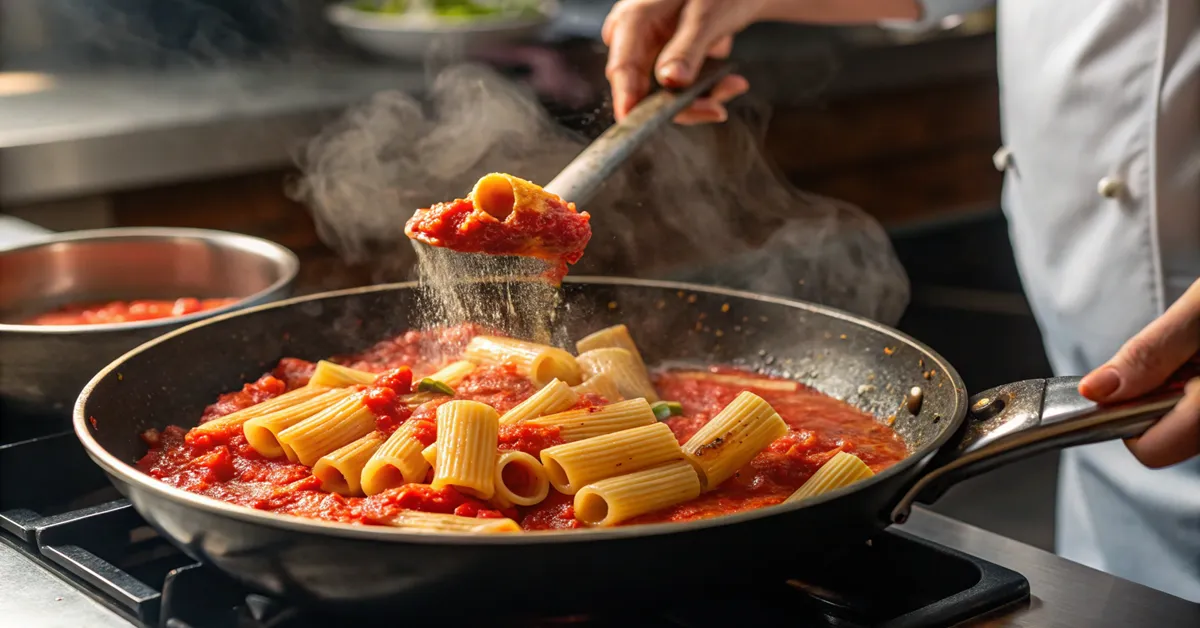
Step 1: The Foundation (Don’t Rush This Part)
First things first – and I cannot stress this enough – mise en place is your friend. That’s fancy chef speak for “get your shit together before you start cooking.” I learned this the hard way when I was simultaneously trying to chop garlic, drain pasta, and answer my mom’s text about whether I’d seen the latest episode of The Bachelor. (Spoiler: multitasking is a myth.)
- Bring a large pot of water to boil. Use more water than you think you need. We’re talking “small swimming pool for pasta” amounts here.
- Salt the water generously. It should taste like the ocean. Not like, “oh, there’s a hint of salt here.” Like you accidentally got seawater in your mouth at the beach.
- Heat olive oil in a large skillet over medium heat. Not medium-high. Not “whatever, close enough.” Medium.
Step 2: The Aromatic Base (Where the Magic Begins)
This is where things get real. You’re going to add minced garlic to that olive oil, and your kitchen is going to smell like heaven had a baby with an Italian restaurant.
- Add garlic and cook for 30 seconds. Don’t walk away. Don’t check Instagram. Don’t do anything but watch that garlic like your rigatoni pomodoro depends on it (because it does).
- Add crushed tomatoes. I like to crush them by hand because I’m extra like that, but you can use a potato masher if you want to maintain some dignity while making rigatoni pomodoro.
- Season with salt, pepper, and red pepper flakes. Taste as you go. This isn’t a chemistry experiment where precision matters – it’s cooking, where instinct and constant tasting reign supreme. (If you want to master the art of tomato-based sauces, this easy vegetable spaghetti recipe is another foundational skill worth learning.)
Step 3: The Pasta Dance (Timing Is Everything)
- Cook rigatoni according to package directions, minus 1 minute. We’re going for al dente because the pasta will finish cooking in the sauce. This is called “mantecatura” and it’s how Italians achieve pasta perfection. (Look at me, dropping Italian cooking terms like I know what I’m doing.)
- Reserve 1 cup of pasta water before draining. This starchy, salty liquid is liquid gold. I used to pour it down the drain like an absolute monster until Marco’s mom gently (okay, not so gently) corrected my ways.
Step 4: The Marriage (Bringing It All Together)
- Add drained pasta to the sauce. Toss everything together like you’re trying to coat every single piece of rigatoni with that beautiful pomodoro goodness.
- Add pasta water gradually until you reach the perfect consistency. It should be saucy but not soupy, clingy but not thick. (I realize this description is about as helpful as “cook until it looks right,” but you’ll know when you see it.)
- Remove from heat and add fresh basil and Parmesan. Toss one final time.
Customization & Variations: Make It Your Own (But Don’t Go Crazy)
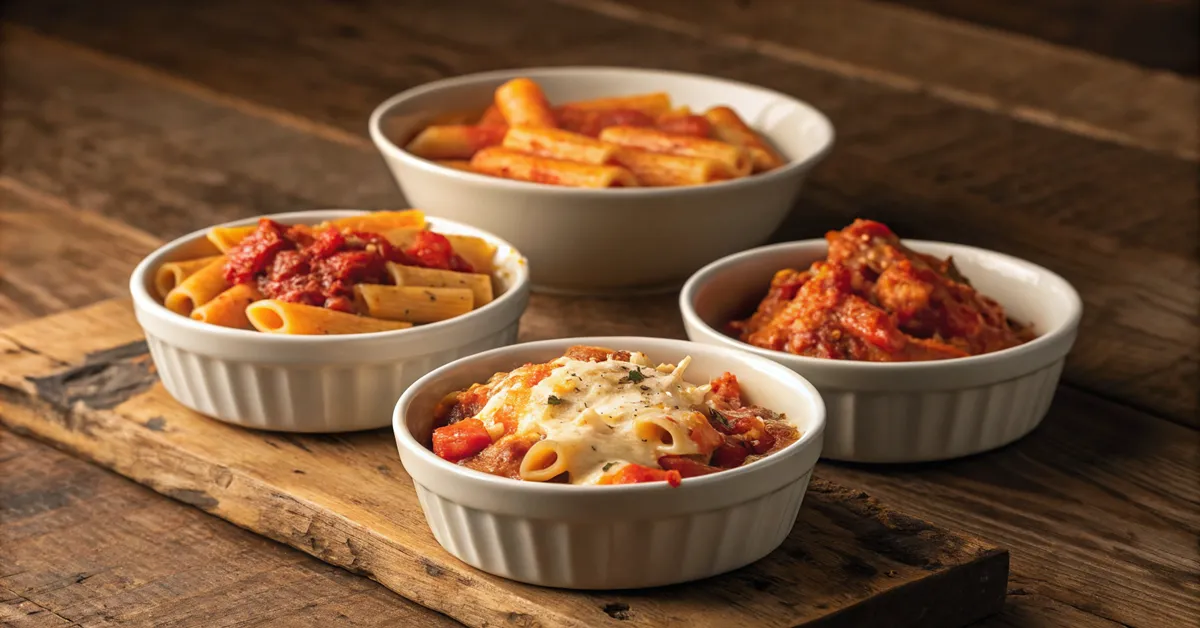
The Spicy Route (For Those Who Like to Live Dangerously)
Want to make spicy rigatoni? Add more red pepper flakes, or better yet, throw in some calabrian chilies. My brother-in-law Tony swears by this combination and honestly? The man knows his spice levels. This spicy rigatoni variation of classic rigatoni pomodoro is perfect for heat lovers.
You could also try the Carbone spicy rigatoni recipe approach – they add vodka to their sauce, which sounds fancy but is basically just an excuse to open wine for the cook. (Not that I’m complaining.)
The Baked Variation (When You Want to Feel Fancy)
Transform this into a baked rigatoni recipe by transferring everything to a baking dish, topping with extra cheese, and baking at 375°F for 20 minutes. It’s like the comfort food version of rigatoni pomodoro – perfect for when you want to feel like you’re eating at your Italian grandmother’s house (even if your actual grandmother was more of a casserole-and-jello-salad type).
Protein Additions (Because Sometimes You Need More)
- Italian sausage: Brown it first, then build the sauce around it
- Chicken: Keep it simple with salt, pepper, and Italian herbs
- Shrimp: Add it in the last few minutes so it doesn’t turn into rubber (for a complete shrimp experience, try this lemon and peper shrimp )
Oh, that reminds me… I once tried to add leftover rotisserie chicken to this dish and it was… fine. Not great, not terrible, just fine. Sometimes fine is enough, you know?
Storage & Meal Prep Tips: Because Leftovers Matter (And I’m Lazy)
The Reality of Pasta Leftovers
Let’s be honest – rigatoni pomodoro is best eaten fresh. But life happens, and sometimes you need to make a big batch of rigatoni pomodoro on Sunday and pretend you have your life together for the rest of the week.
Refrigerator storage: Up to 3 days in an airtight container. The pasta will absorb some of the sauce, so add a splash of water or stock when reheating.
Freezer storage: Up to 3 months, though the texture won’t be quite the same. I learned this during my brief “meal prep queen” phase of 2023. (It lasted exactly two weeks.)
Reheating Without Ruining Everything
- Stovetop: Add a splash of water or broth to a pan, add the pasta, and heat gently
- Microwave: Cover and heat in 30-second intervals, stirring between each
- Oven: Cover tightly with foil and heat at 350°F for 15-20 minutes
(Pro tip: never reheat pasta in the microwave without covering it. I once turned my lunch into what looked like a crime scene.)
FAQ Section: All Your Burning Questions (That I’ve Probably Asked Too)
What is pomodoro rigatoni?
Rigatoni pomodoro is a classic Italian pasta dish featuring tube-shaped rigatoni pasta tossed in a simple tomato-based sauce made with garlic, olive oil, tomatoes, and fresh basil. It’s the kind of dish that looks fancy but is actually surprisingly simple – which is probably why it’s survived as a staple of Italian cuisine for generations.
What is pomodoro sauce made of?
Pomodoro sauce is made from just a few high-quality ingredients: good olive oil, garlic, ripe tomatoes (preferably San Marzano), salt, and fresh basil. That’s it. No cream, no complicated reductions, no ingredients you can’t pronounce. The magic is in the simplicity and the quality of each component.
What is the meaning of pomodoro sauce?
The word “pomodoro” literally translates to “golden apple” in Italian – that’s what tomatoes were called when they first arrived in Italy from the Americas in the 16th century. Pomodoro sauce represents the foundation of Italian cooking: taking a few perfect ingredients and letting them shine without overcomplicating things.
What is the difference between pomodoro and marinara?
This is where things get a bit… controversial. Pomodoro sauce is typically chunkier and often includes fresh basil, while marinara is usually smoother and might include oregano and other herbs. Pomodoro is more of a “rustic” approach, while marinara is often more refined. (But honestly? The lines blur depending on who’s cooking and what region of Italy they’re from.)
Is pasta pomodoro healthy?
Rigatoni pomodoro can definitely be part of a healthy diet! Tomatoes are packed with lycopene and vitamins, olive oil provides healthy fats, and pasta gives you energy. The key is portion control and using quality ingredients. It’s certainly healthier than most takeout options – trust me, I’ve done the research (and by research, I mean I’ve ordered way too much delivery).
Why do Italians call it pomodoro?
As I mentioned earlier, “pomodoro” means “golden apple” because early tomatoes were yellow and reminded people of apples. The name stuck even as red varieties became more common. It’s one of those linguistic quirks that makes food history fascinating – like how we still say “dial” a phone number even though most of us have never seen a rotary phone.
Nutrition Information: The Good News (Mostly)
Okay, disclaimer time: I’m not a nutritionist, and these numbers are approximate. Please don’t base your life decisions on my amateur math skills.
Per serving (serves 4-6):
- Calories: 420-480 (depending on how heavy-handed you are with the cheese)
- Carbohydrates: 65-70g
- Protein: 15-18g
- Fat: 12-15g (mostly from that beautiful olive oil)
- Fiber: 4-5g
- Sodium: Variable (depends on your salt enthusiasm)
The good news? Rigatoni pomodoro is actually pretty balanced. You’ve got complex carbs from the pasta, healthy fats from the olive oil, and nutrients from the tomatoes. Plus, if you load it up with fresh basil, you’re basically eating a salad, right? (Don’t answer that.)
My Personal Reflection (And What I’ve Learned)
So here we are, at the end of my rambling love letter to rigatoni pomodoro. What started as a disaster that nearly ended my relationship with my mother-in-law has become one of my most reliable dishes. (She actually asked for my rigatoni pomodoro recipe last Christmas, which I’m choosing to interpret as acceptance into the family.)
The thing about rigatoni pomodoro is that it teaches you patience. You can’t rush good tomato sauce. You can’t skip steps and expect perfect results. You have to trust the process, even when it seems too simple to work.
Wait, where was I going with this? Right – the life lessons. (See what I mean about the tangents?)
I’ve made this dish probably fifty times since that first disaster, and I’m still learning things. Sometimes I add a splash of white wine (okay, fine, I add wine and then drink the rest while cooking). Sometimes I throw in some fresh mozzarella at the end. Sometimes I make it exactly as written because perfection doesn’t need improvement.
But here’s what I want you to remember: your first attempt might not be perfect. Hell, your tenth attempt might not be perfect. But each time you make rigatoni pomodoro, you’re participating in this beautiful, messy tradition of feeding people you care about with simple, honest ingredients.
And honestly? Even imperfect rigatoni pomodoro is better than perfect takeout.
Hey, if you survived this rambling mess of a recipe, maybe check out some of my other pasta adventures? No pressure though – I know I can be a lot sometimes.
Also, seriously, let me know in the comments if you try this rigatoni pomodoro recipe. Did it work? Did you add your own twist? Did you also almost serve tomato soup to your in-laws? We’re all friends here.
P.S. – Yes, I realize I used “rigatoni pomodoro” quite a bit in this article. It’s called SEO, people. Also, I may have gotten a little carried away with my pasta enthusiasm.

